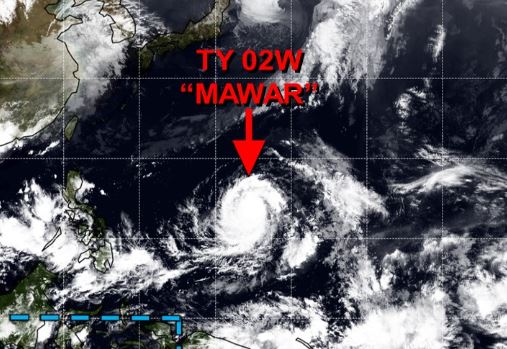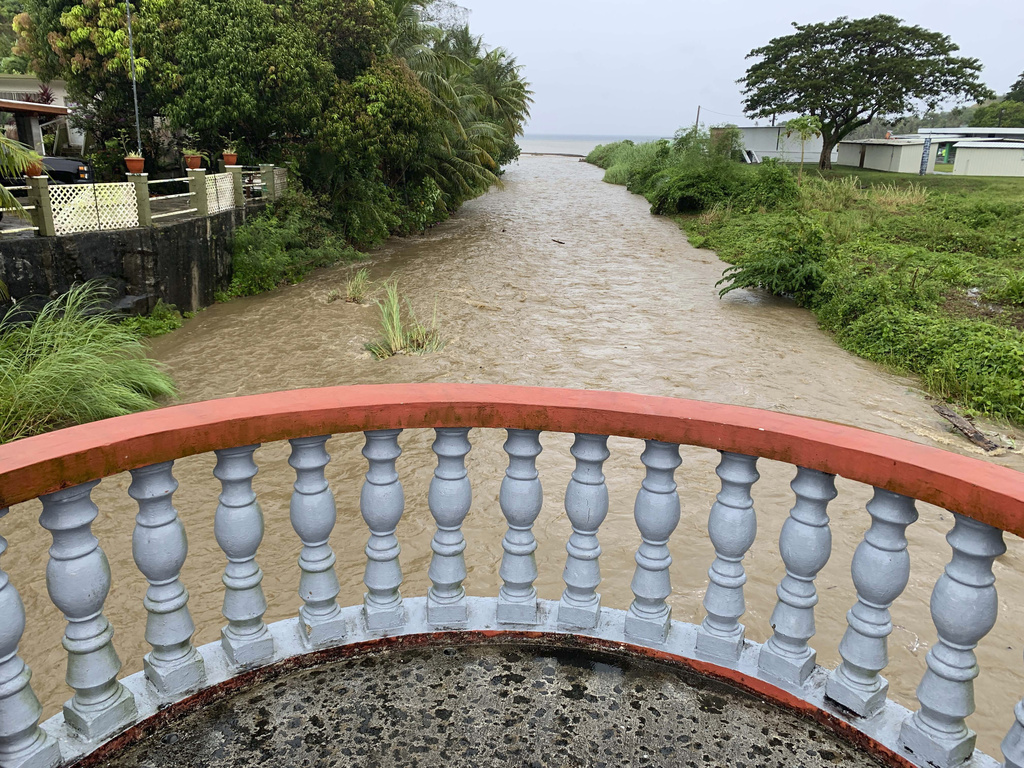HONOLULU (AP) — Typhoon Mawar barreled into Guam as a powerful Category 4 storm Wednesday, pummeling the U.S. Pacific territory with high winds, heavy rains and a dangerous storm surge that swamped low-lying areas as residents hunkered down in homes and shelters.
The typhoon passed over the northern tip of Guam on Wednesday evening, the National Weather Service said.
The weather service earlier warned of a “triple threat” of winds, torrential rains and life-threatening storm surge, and officials were bracing for “considerable damage” including non-reinforced concrete walls being blown down, fuel storage tanks rupturing and overturned cars.
The weather service warned that it is extremely dangerous and life threatening situation and people should take cover and remain in shelter for the next few hours.
Residents of Guam stockpiled supplies, battened down windows and abandoned wood and tin homes for emergency shelters as Super Typhoon Mawar bore down as the strongest storm to approach the U.S. Pacific territory in decades.
The U.S. military sent away ships, President Joe Biden approved an emergency declaration and anyone not living in a concrete house was urged to seek safety elsewhere ahead of Mawar.
Guam Gov. Lou Leon Guerrero said on social media that the emergency declaration will support the mobilization of resources into Guam, which is “especially crucial given our distance from the continental U.S.” Guerrero ordered residents of coastal, low-lying and flood-prone areas of the territory of over 150,000 people to evacuate to higher elevations.
Federal assistance will be needed to save lives and property. Guerrero said in a letter to the president requesting a “pre-landfall emergency” for Guam. Officials warned residents who aren’t in fully concrete structures — some homes on the far-flung island are made of wood and tin — to consider relocating.
Guam is a crucial hub for U.S. forces in the Pacific, and the Department of Defense controls about a third of the island. Rear Adm. Benjamin Nicholson, Joint Region Marianas commander, authorized the evacuation of defense personnel, dependents and employees in areas expected to be affected.

All ships were moved out to sea as a standard precaution, according to the Navy, and any personnel remaining on the island were sheltering in place. About 6,800 U.S. service members are assigned to Guam, according to the Pentagon.
Guerrero urged residents in a YouTube message to remain calm and ordered the National Guard to help those in low-lying areas evacuate as people stocked up on water and generators.
“We are at the crosshairs of Typhoon Mawar,” she said. “Take action now, stay calm, stay informed and stay safe.”
A storm surge of 6 to 10 feet (2 to 3 meters) above the normal high tide was expected and could reach as high as 15 feet (4 1/2 meters). Surf was expected to build sharply in the next day or two along south- and east-facing reefs, with dangerous surf of 20 to 25 feet (6 to 7 1/2 meters) into Wednesday, the weather service said.
The storm was moving at only 3 mph (5 kph) but had an eye 17 miles (27 kilometers) wide, meaning people at the typhoon's center could see calm conditions for over three hours and conclude, far too soon, that the worst is over, Doll said. As the eye leaves, the winds could rise to 150 mph (241 kph) in minutes, so people should remain sheltered until the government gives the all-clear, he said.
“Folks may say, ‘Hey it’s over, we could go outside and start cleaning up,’” Doll said. “That is totally wrong.”
The weather service warned that “considerable damage” was expected, including non-reinforced concrete walls being blown down, fuel storage tanks rupturing, overturned cars and uprooted trees that could cut off residential areas for days or weeks.
Guam resident Albert Eliasson told KUAM News he was battening down and stocking up, including ensuring there was enough water to drink and flush toilets.
“Just making sure that we have things prepared, shutters on the windows that need it,” he said.

Another resident, Oshean Saralu, told KUAM he too was doing everything he could to prepare: “We usually pack everything up for most of our stuff inside our garage and just secure everything, especially the windows.”
Rota, an island in the U.S. Commonwealth of the Northern Mariana Islands, was also under a typhoon warning, Doll said. Tinian and Saipan, in the Northern Marianas, were under tropical storm warnings. Some people in those areas are still in temporary shelters or tents after Category 5 Super Typhoon Yutu in 2018, Doll noted.
Typhoon season runs from July 1 to Dec. 15 in the western North Pacific, according to the weather service.
“Mawar isn’t terribly unusual in location, but certainly in strength,” said University of Albany atmospheric science professor Kristen Corbosiero, a tropical cyclone expert. Usually one or two storms a year come within 50 miles of the island, she said.
The western Pacific is “a notorious breeding ground for intense tropical cyclones,’’ said Yale Climate Connections meteorologist Jeff Masters. “They’ve got a much bigger area to romp around in and more time to intensify.”
